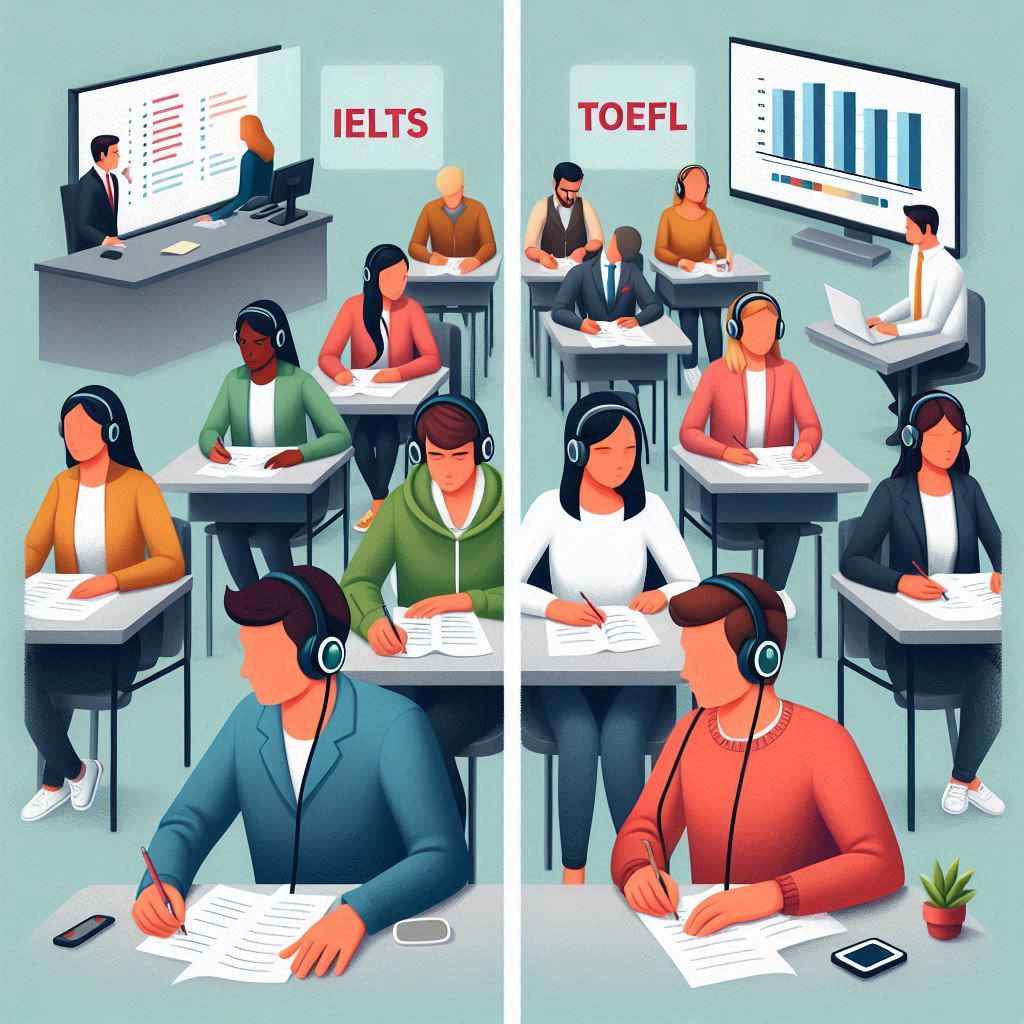Compare IELTS Vs TOEFL Which is Better In 2024 is better for you. Explore the key differences and make an informed decision on which exam suits your needs best.
Table of Contents
IELTS Vs TOEFL: Which One You Should Choose In 2024?
If you’re planning to study or work abroad, chances are you’ll need to take an English proficiency test. The two most popular exams are the IELTS (International English Language Testing System) and the TOEFL (Test of English as a Foreign Language). Both are widely accepted by universities and employers around the world, but which one is better for you in 2024? In this post, we’ll compare the IELTS and TOEFL, examining their formats, scoring, acceptance, and more, to help you make an informed decision.

What is IELTS?
The IELTS is an English language proficiency test developed by the British Council, IDP: IELTS Australia, and Cambridge Assessment English. It measures your ability to communicate in English in all four language skills: listening, reading, writing, and speaking. There are two versions of the IELTS: Academic and General Training. The Academic version is for those who want to study at a university or college, while the General Training version is for those who need English for work, migration, or training purposes.
What is TOEFL?
The TOEFL is an English language proficiency test developed by the Educational Testing Service (ETS). It also measures your ability to communicate in English across all four language skills: listening, reading, writing, and speaking. The TOEFL iBT (Internet-based Test) is the most common format, although a paper-based version (TOEFL PBT) is also available in certain regions. The TOEFL iBT is primarily used for academic purposes, particularly for admission to universities and colleges.
Comparison Table: IELTS vs. TOEFL
| Feature | IELTS | TOEFL |
|---|---|---|
| Test Versions | Academic, General Training | iBT (Internet-based Test), PBT (Paper-based Test) |
| Test Format | 4 sections: Listening, Reading, Writing, Speaking | 4 sections: Reading, Listening, Speaking, Writing |
| Test Duration | 2 hours 45 minutes | 3 hours (plus 10-minute break) |
| Speaking Section | Face-to-face interview with an examiner | Recorded responses via computer |
| Scoring | Band scores (0-9) for each section; Overall band score (0-9) | Scaled scores (0-30) for each section; Total score (0-120) |
| Accepted In | Over 10,000 institutions in 140+ countries | Over 11,000 institutions in 150+ countries |
| Accent | British and Australian English | American English |
| Availability | 48 test dates per year | Over 50 test dates per year |
| Cost | Varies by country, typically $215-$250 | Varies by country, typically $160-$250 |
Detailed Breakdown
Test Format
- IELTS: The test is divided into four sections—Listening, Reading, Writing, and Speaking. The Listening and Speaking sections are the same for both the Academic and General Training versions, while the Reading and Writing sections differ. The Speaking section is conducted as a face-to-face interview with a trained examiner, which can take place on the same day as the other sections or up to a week before or after.
- TOEFL: The TOEFL iBT consists of four sections—Reading, Listening, Speaking, and Writing. The Speaking section involves speaking into a microphone, and responses are recorded and evaluated later. The TOEFL PBT, available in limited regions, has different sections and includes a separate Test of Written English (TWE).
Scoring
- IELTS: Scores are reported as band scores on a scale from 0 to 9, with each section receiving a band score and an overall band score calculated as the average of the four sections. Universities often require an overall band score of 6.5 to 7.5.
- TOEFL: Each section is scored on a scale of 0 to 30, and the total score is the sum of the four section scores, ranging from 0 to 120. Universities typically require a total score of 80 to 100.
Acceptance
- IELTS: Accepted by over 10,000 institutions in more than 140 countries, including the UK, Australia, Canada, and the USA. It is particularly favored by institutions in the UK and Commonwealth countries.
- TOEFL: Accepted by over 11,000 institutions in more than 150 countries, including the USA, Canada, the UK, Australia, and New Zealand. It is particularly favored by institutions in the USA.
Availability and Cost
- IELTS: Offered up to 48 times a year, depending on the test center. The cost varies by country but typically ranges from $215 to $250.
- TOEFL: Offered more than 50 times a year. The cost also varies by country, typically ranging from $160 to $250.
Which Test Should You Choose?
The choice between IELTS and TOEFL depends on several factors:
- Preferred Test Format: If you are comfortable speaking in front of a person, the IELTS Speaking section might be better for you. If you prefer speaking into a microphone, TOEFL might be a better choice.
- University Requirements: Check the specific requirements of the universities or institutions you are applying to. Some might prefer one test over the other.
- Accent Preference: If you are more accustomed to British or Australian English, you might find the IELTS easier. If you are more familiar with American English, TOEFL might be a better fit.
- Test Availability and Location: Consider the availability of test dates and locations near you.
Which is better for Indian students IELTS or TOEFL?
Choosing between IELTS (International English Language Testing System) and TOEFL (Test of English as a Foreign Language) can be a significant decision for Indian students planning to study abroad. Both tests assess English language proficiency but differ in format, acceptance, and focus. Here’s a detailed comparison to help you decide which might be better for you.
IELTS (International English Language Testing System)
Format: IELTS consists of four sections: Listening, Reading, Writing, and Speaking. The Speaking section is a face-to-face interview with an examiner, which some students find more personal and less stressful than speaking into a microphone.
Acceptance: IELTS is widely accepted in the UK, Australia, New Zealand, and many institutions in Canada and the US. It is also recognized by various professional organizations and immigration authorities.
Content: The test covers a broad range of scenarios, including both academic and general contexts. This makes it suitable for students, professionals, and those seeking immigration.
Accents: IELTS features a variety of English accents, including British, Australian, and American, which might be more familiar to Indian students who are exposed to diverse English accents through media and education.
Scoring: IELTS scores range from 0 to 9, with each section scored individually and then averaged to form an overall band score.
TOEFL (Test of English as a Foreign Language)
Format: TOEFL also includes four sections: Reading, Listening, Speaking, and Writing. However, the Speaking section is recorded and sent to evaluators, which some students might find less intimidating than a face-to-face interview.
Acceptance: TOEFL is highly preferred by universities in the US and is also accepted in Canada, Australia, and New Zealand. It is particularly popular among institutions in North America.
Content: TOEFL is more academically focused, with tasks resembling university-level coursework. This includes lectures, discussions, and reading passages that are typical in a university setting.
Accents: TOEFL primarily features North American accents, which might be challenging for some students who are less familiar with them.
Scoring: TOEFL scores range from 0 to 120, with each section scored out of 30.
Key Differences between IELTS And TOEFL
Test Length: IELTS is about 2 hours and 45 minutes long, while TOEFL is around 3 hours. The difference in length might be a consideration for students who prefer shorter tests.
Cost: Both tests have similar costs, but this can vary slightly depending on the location. It’s important to check the current fees in your area.
Test Format Preference: If you prefer a face-to-face speaking test, IELTS might be more suitable. If you are comfortable with a recorded speaking test, TOEFL could be a better option.
IELTS Vs TOEFL: Which one You should Choose?
Academic Goals: If you’re aiming for universities in the US, TOEFL might be more suitable due to its preference among American institutions. For the UK, Australia, or New Zealand, IELTS is often preferred.
Test Format Preference: Consider which test format you feel more comfortable with. If you prefer interacting with a person during the speaking test, IELTS is the way to go. If you are more comfortable speaking into a microphone, TOEFL might be better.
Preparation: Think about the preparation materials and resources available for each test. Both IELTS and TOEFL have extensive preparation materials, but you might find one more accessible or suited to your learning style.
Test Centers and Availability: Check the availability of test centers in your area. Both tests are widely available, but you might find one more convenient to schedule.
Personal Strengths: Reflect on your strengths and weaknesses in English. If you are strong in academic English and familiar with North American accents, TOEFL might be a good fit. If you are more comfortable with a variety of accents and prefer a broader range of topics, IELTS could be better.
Ultimately, the choice between IELTS and TOEFL depends on your specific needs, goals, and preferences. Both tests are respected and widely accepted, so you can’t go wrong with either. It’s important to research the requirements of the institutions you’re applying to and consider which test format you feel more comfortable with.
Which one is harder, IELTS or TOEFL?
Determining whether IELTS or TOEFL is harder depends on individual preferences and strengths. Here’s a comparison:
IELTS (International English Language Testing System)
- Format: Four sections – Listening, Reading, Writing, and Speaking. The Speaking section is a face-to-face interview.
- Content: Covers both academic and general contexts.
- Accents: Features a variety of English accents.
- Scoring: Scores range from 0 to 9.
TOEFL (Test of English as a Foreign Language)
- Format: Four sections – Reading, Listening, Speaking, and Writing. The Speaking section is recorded.
- Content: More academically focused.
- Accents: Primarily features North American accents.
- Scoring: Scores range from 0 to 120.
Key Differences
- Test Length: IELTS is about 2 hours and 45 minutes, while TOEFL is around 3 hours.
- Question Types: IELTS includes various question types; TOEFL mainly uses multiple-choice questions.
- Speaking Format: IELTS has a face-to-face interview; TOEFL’s speaking section is recorded.
Which is Harder IELTS Or TOEFL?
- IELTS: Might be easier if you prefer face-to-face interaction and are comfortable with different accents.
- TOEFL: Might be easier if you prefer a recorded speaking test and are familiar with academic English and North American accents.
How much does TOEFL cost in India ?
The TOEFL exam fee in India is approximately Rs. 17,000. This amount covers your registration for the exam. Whether you choose to complete the exam at home or at a test center, the fee remains the same. Keep in mind that additional fees may apply for services like rescheduling or score reviews .
If you’re planning to take the TOEFL Essential Test, the fee is around Rs. 9,996 .
Conclusion
Both IELTS and TOEFL are excellent tests that can open doors to educational and professional opportunities worldwide. Your choice should be based on your personal preferences, test-taking strengths, and the specific requirements of the institutions you wish to apply to. By understanding the differences and similarities between these two tests, you can make an informed decision that best suits your needs in 2024.

